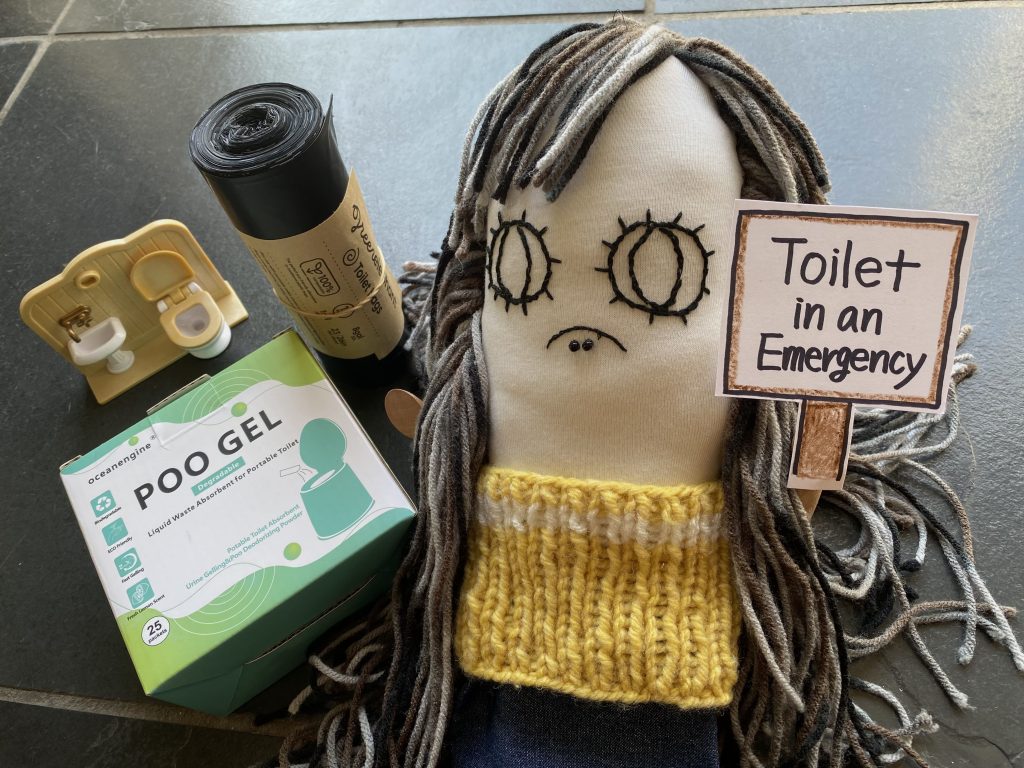
What should I prepare as an emergency toilet, in the home?
“I know! I’ll just cover the toilet seat with a plastic bag, right?“
“I have never once thought about emergency toilets.”
“Somebody will set up portable toilets, right?”
To begin with, please do not expect to be able to pee and poo normally, in an emergency. You might have an incredibly inconvenient toilet situation that involves more and more waste accumulating in your home. Can you picture that? After a major disaster, you might have water outages or sewerage problems. You might not be able to flush the toilet (see post #61). If you are lucky enough to stay in your home, how will you handle these problems?
Another possible scenario is that you do have to evacuate from your home, and you end up in an emergency shelter. What kind of facilities do you expect to find in the evacuation shelter? Will there be nice, clean restrooms waiting for you? In reality, no. Far from it. In fact, the bathrooms may be much worse than just dirty. The number of toilets may be woefully inadequate for the number of people. There may be zero privacy. It might be unsanitary to the point of being downright dangerous. There could be criminals and predators lurking. (If you want to know how bad it can get, check out these articles about the New Orleans Superdome after hurricane Katrina: one from the Seattle Times, and one from USA Today.) You think a bunch of people can keep restrooms clean for extended periods of time? Umm…..
Considering the possibilities, let’s try to prepare an emergency toilet, as best we can.
Emergency toilets in your home
Personally, I don’t want to buy a big emergency toilet kit. To the extent possible, I try to prepare my emergency toilet using ordinary, daily goods.
★ Use a plastic bag (compostable toilet bag) and stretch it over the toilet seat. Use this along with portable toilet absorbent gel.
・If you don’t have absorbent gel, use newspapers, baby diapers or pet pads.
Newspaper has a deodorizing effect!!
・Using your own toilet as a seat is a good idea, but be careful if you still have water in the toilet. When the bag fills up, it will become heavier, and it might hang low enough to touch the toilet water.
First cover your toilet with one plastic bag, then cover it with a second bag. After you pee or poo, dispose of the second bag only, and keep the first one for next time.
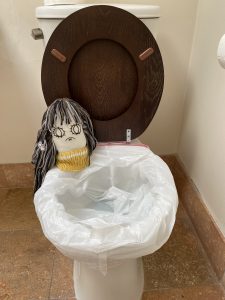
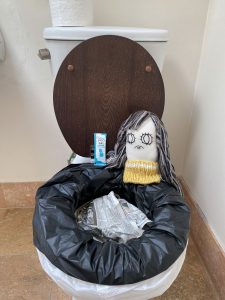
★ Get a portable toilet kit, if you want. (This is the easy way.) RESTOP is a good example of the portable toilet kit.
It’s up to you if you want to pick
up an emergency toilet kit.
★ If we run out of toilet paper, we don’t need to wipe pee, but we will still need to find an alternative …
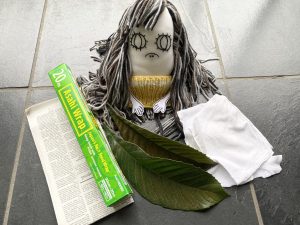
- Newspapers, magazines or used printer paper.
- Plants, but not poisonous ones (check out greenbelly.co for help with this).
- Old sheets, clothes or fabric.
- Plastic bags or wrappers.
- Water.
Keep the all trash in a big mylar bag to protect against odors, if you have one. And then dispose of it, when you can.
Check the plants in your neighborhood
while you are out walking.
You might find a good natural wipe!
★ Keep water in a bucket, and use the water to wash your hands. Or if you have a plastic (PET) bottle, you can make this DIY handwasher. (Also, check out this site: Hero-in-my hood.)
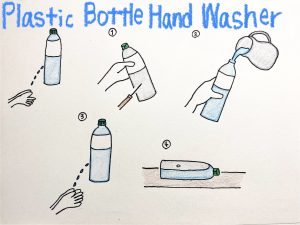
- Use an ice pick or a knife to poke a small hole near the bottom of a plastic bottle.
- Place your thumb over the hole, and fill the bottle with water. After you screw the cap back on, you can remove your thumb from the hole, and the water will not spill.
- When you need to wash your hands, loosen the cap, and the water will flow.
- When not in use, lay the bottle flat, with the hole facing up.
Collect all of your waste, and then you’re done!! …right? No, no, no. We have another important step. Where will we throw everything away? Remember, garbage trucks will probably not collect garbage, normally, during or immediately after a disaster. We don’t know when or how often the garbage trucks will come to pick up our collected pee and poop. So you can guess what is going to happen. There will be piles of trash on the street… Smelly feces… Files swarming… Eeew. It’ll be gross.
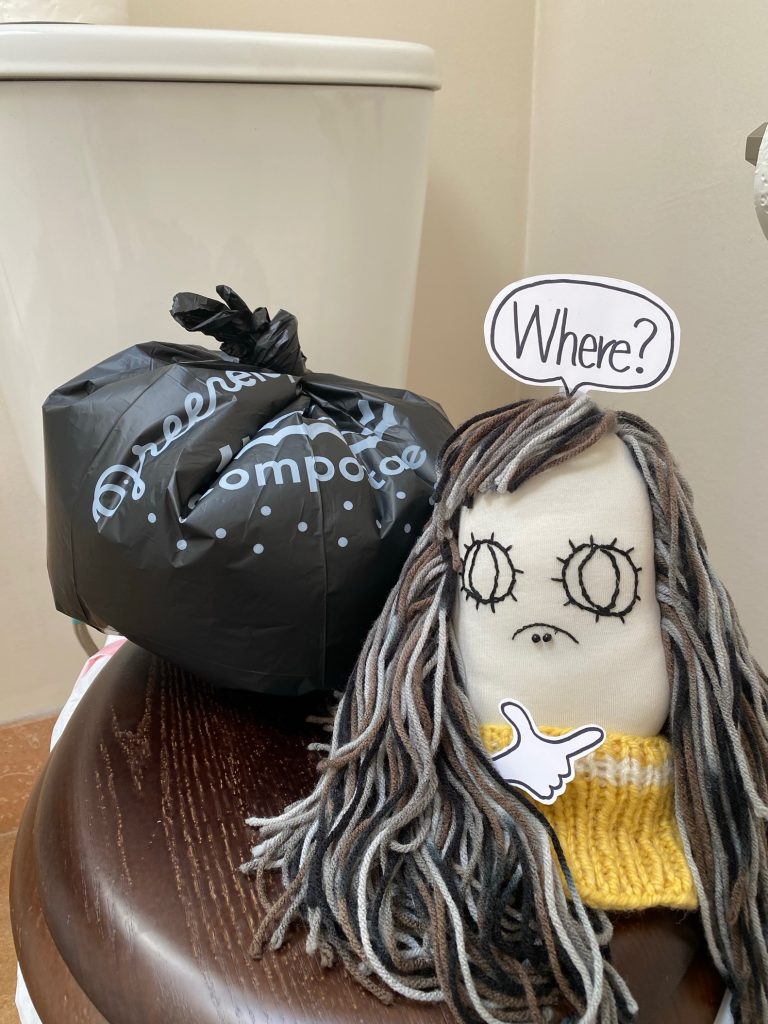
How about an incineration plant? They also might not be operational after a disaster. In the worst case scenario, we have to burn our trash by ourselves. When the entire town is damaged and dysfunctional, we will have no choice but to burn our own trash. This web site shows how to burn trash: wikihow / Common Sense Home.
Emergency toilets outside
★ Retractable Portable Toilet (e.g., Trip Tips): You can use this in the car and set it up on top of a seat. Also, we can carry it easily and look for a private space to do our business. And finally, we can use this for other purposes, not just as a toilet (so long as we keep it clean).
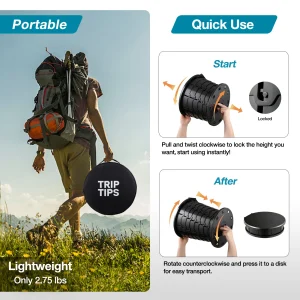
I will be able to keep it clean, so long as it’s only my family using it. (Because I will nag them!) Cover the seat with a compostable toilet bag, and use absorbent, portable toilet gel. (See post #62.)
★ Use a manhole toilet system (see Funabashi City) or the big portable toilets which the government sets up. But if the government can set up temporary toilets, it means they might be able to collect our trash after peeing and pooping, too.
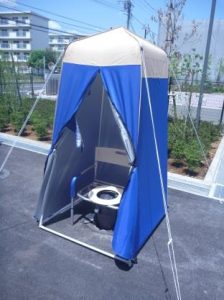
★ Dig a hole and use it as a toilet, as a last resort. This approach will be hard if it is raining, or if it’s dark, or if you have kids, etc.
I’m a little nervous opening up about this toilet topic, publicly. But it is a very important topic, health wise. I don’t think I know enough about this topic, yet. When I learn more about emergency toilets, I will include what I learn in a future post.
See you next time.
Remember, “Protect your life by yourself” (自分の命は自分で守る). You need to survive first, and then you need your emergency supply. No matter how well you prepared your emergency supplies, if you die, then all of your preparations will have been for nothing. First and foremost, keep your health up all the time. Build your stamina so that if you need to, you can evacuate as quickly as possible. Stay healthy.
Here is a little more Japanese toilet-related info, if you are interested.
災害時におけるトイレ・し尿処理対策:岡山 朋子さん
携帯・簡易トイレは「ゴミに出す方法」のこと(ゼロからわかる携帯・簡易トイレ):長谷川高士さん くまもと水と福祉の研究室
Pingback: Diapers in an Emergency (for Adults) #66 – Goriyama
Pingback: Diapers in an Emergency (for Babies) #65 – Goriyama
Pingback: The Period (Menstrual Hygiene) in Emergencies #64 – Goriyama